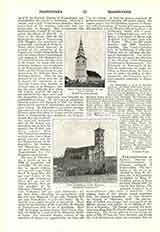

Transylvania (or ERDELY), Diocese of (TRANSILVANIENSIS), in Hungary, suffragan of Kalocsa Buts. The foundation of the see is attributed to King St. Stephen, but it was probably established by King St. Ladislaus, patron of Transylvania; Simon (1103-13) was the first bishop. The episcopal residence is at Gyula-Fehervar (Alba Julia) in Also-Feher. The original limits of the diocese varied somewhat from the present boundaries, as they included the County of Marmaros, while the provostship of $zeben was exempt and some parts of the Szekler country were subject to the Bishop of Milkovia in Rumania. The bishops received rich donations from King Bela IV, Charles Robert, Louis I, and Sigismund. The diocese suffered greatly during the reign of Bela IV from the Tatar invasion, and during the civil disturbances under his successors, but recovered very quickly in the fourteenth century. The see was again imperilled by the advance of the Turks, but its decay did not set in until the sixteenth century, and was caused by the progress of Lutheranism, in consequence of which the exempt provostship of Szeben ceased to exist, and by internal disturbances in Transylvania. It flourished again under Cardinal Martinuzzi, but after his assassination in 1551 it decayed rapidly. The advance of Protestantism led, in 1556, to the secularization of the see, which was, however, reestablished by Prince Stephen Bkthory. After the coming of the Jesuits the Catholic Faith flourished again, but only while the house of Bkthory continued to rule. Bishop Demetrius Ngyi was forced to leave the see, and in 1601 the cathedral of Gyula-Fehervar, which had been founded in the thirteenth century, was taken and held by the Protestants until the eighteenth century, the Catholics not regaining possession of it until the reign of Charles III.
When the Principality of Transylvania lost its independence, the decrees against the Catholic Church were withdrawn, but the bishopric and chapter were not reestablished until 1713. The succession to the see had been kept up regularly till 1713, but the bishops resided abroad. The exempt provostship of Szeben was incorporated in the bishopric, which was completely restored under Maria Theresa in 1771. Of the bishops, who filled the see after 1713, the following may be mentioned: Ignatius Count Batthyany (1780-98), who founded the library at Gyula-Fehervar, which is named after him; Alexander Rudnay (1816-19), later Archbishop of Gran; Louis Haynald (1852-64), afterwards Archbishop of Kalocsa. Count Gustavus Majlath has occupied the episcopal see since 1897. The diocese contains: 16 archdeaconries; 10 titular abbeys; 2 titular provostships; 229 parishes; 398 secular priests; 226 regular clergy; 30 monasteries of men and 17 convents of nuns; the Catholics number 354,145. There are 103 patrons. The chapter consists of 10 active members and of 6 titular canons. Catholics are to a certain extent autonomous, i.e., certain church and school matters are managed by mixed boards, partly clerical, partly lay. This autonomy dates back to the time of the Reformation; it ceased in 1767 with the establishment of the Commissio catholica by Maria Theresa, and was reestablished as late as 1873. The control is exercised by the general assembly of the Catholic estates and a managing committee.
A. ALDASY

